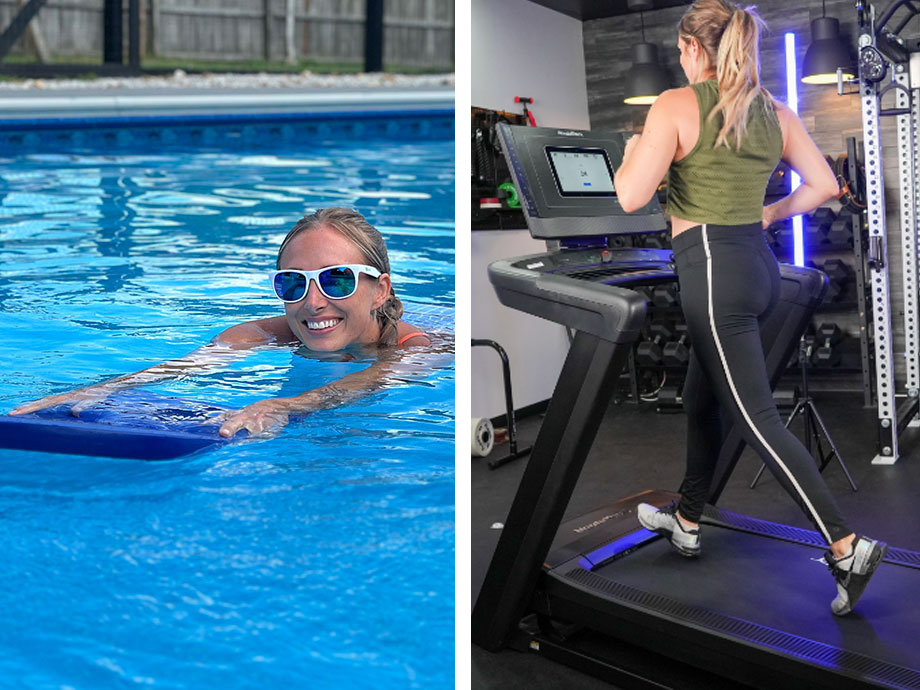We test and review fitness products based on an independent, multi-point methodology. If you use our links to purchase something, we may earn a commission. Read our disclosures.
Swimming and running are classic cardio powerhouses known for torching calories. They have similarities but even more differences, like the muscle groups activated, amount of joint stress, and breathing patterns that might make you wonder if swimming is better than running for your cardiovascular exercise needs.
The answer to “swimming vs running” will depend on your goals, access to a pool or safe running locations, and individual health factors. Here, we’ll take an in-depth look at all the potential health benefits each exercise offers and help you determine which cardio form is best for your workout routine and personal fitness goals.
Swimming Vs Running For Weight Loss
Many people start swimming or running to lose weight. And both can indeed burn an impressive number of calories. But weight loss takes burning more calories than you consume. You can potentially exercise regularly and not lose weight because of calorie consumption.
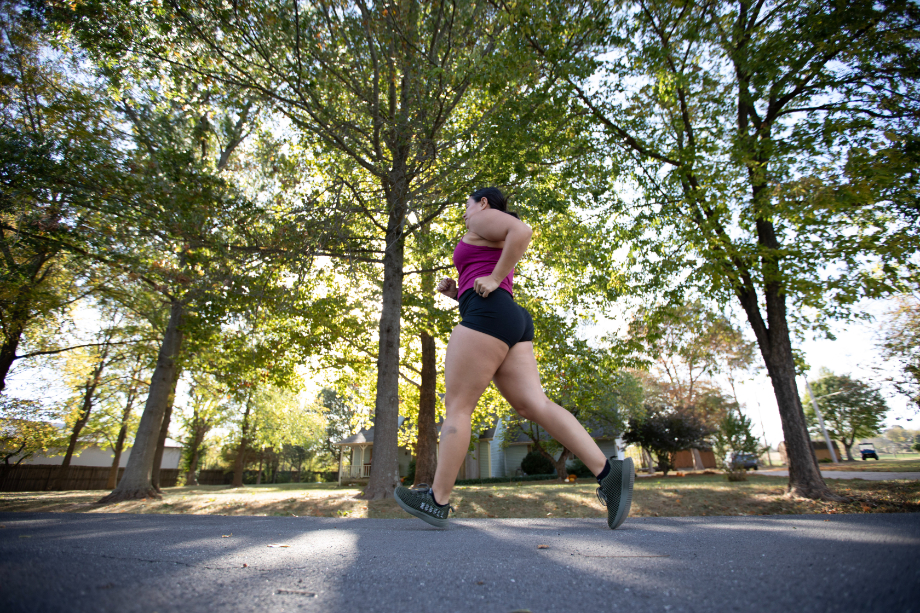
However, if you look at calorie burn alone, high-intensity running will win almost every time. Here’s a quick calorie burn comparison using the American Council on Exercise (ACE) calorie counter1:
| Calories Burned* | ||
| Casual | Vigorous | |
| Swimming | 238 | 340 |
| Running | 272 | 397 |
*150-pound adult
RELATED: Activities That Burn the Most Calories
Depending on the intensity and time spent doing the activity, swimming or running can burn enough calories to lose weight. However, consider how long and at what intensity you swim or run. For example, if you can only run for five minutes because it hurts your knees, but you can swim for 45 minutes, you’ll burn more calories swimming than running.
A 2014 study published in Applied Physiology, Nutrition, and Metabolism2 found evidence that obese individuals chose resistance exercise and swimming over running and sports. Researchers hypothesized that these exercises were more accessible than running and other high-impact sports for this group of people, making swimming or resistance training a better option.
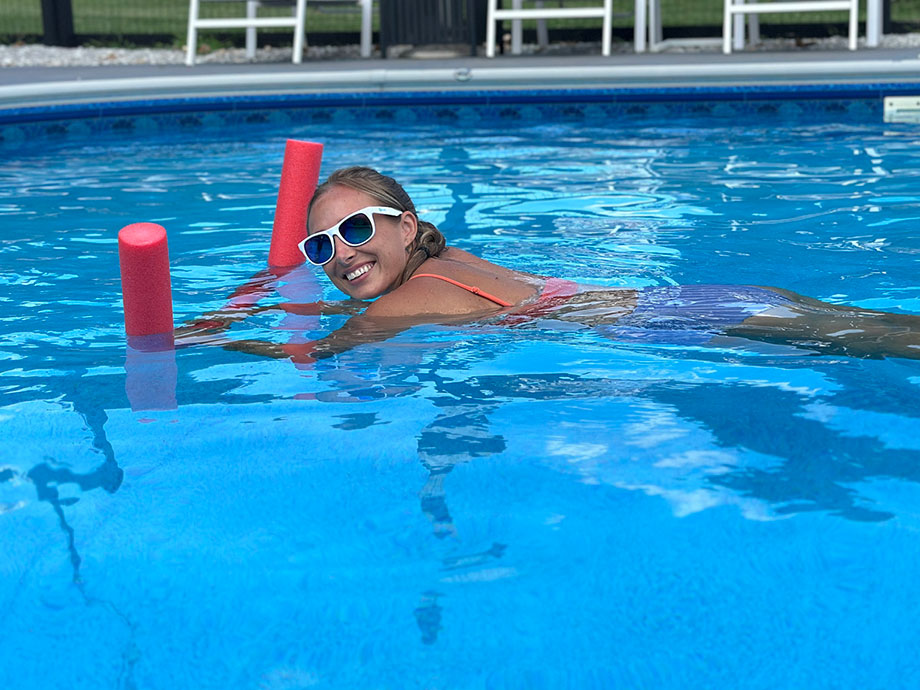
If you hate running and love swimming, then the activity you’ll do more regularly (in this example, swimming) makes more sense for weight loss, even if you can burn more calories running. At the same time, many beginners find running easier than swimming, especially if they don’t know how to swim. If swimming is intimidating, your lung capacity is lacking, or you simply don’t like it, burn those calories running instead.
Any movement is better than no movement.
RELATED: 12 Low-Impact Pool Exercises
Swimming Vs Running For Cardiovascular Health
Cardio exercises like running and swimming work wonders for cardiovascular health by reducing insulin resistance, hypertension (high blood pressure), and arterial stiffness³, among many other benefits.
A small research study published in Frontiers in Physiology⁴ compared the hearts of swimmers and runners. While both groups showed impressive cardiovascular benefits with stronger hearts and lungs than the average person, runners had larger left ventricles.
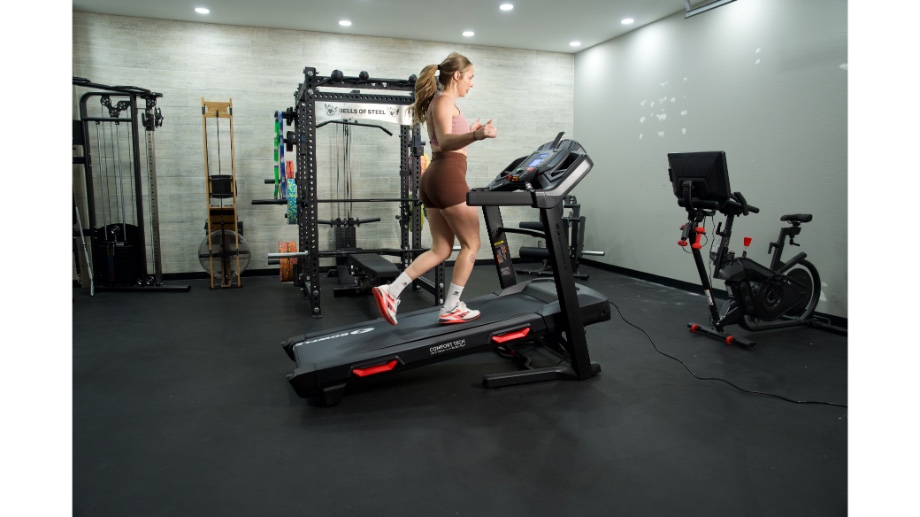
So, if you’re being nitpicky, a weight-bearing exercise like running has a slight cardio advantage. As for swimming, while it’s more of a low-impact exercise, you’re still getting in a workout, just with less possible joint pain. So, you can’t go wrong with either type of cardio exercise.
RELATED: Alternatives To Running For Cardio
Swimming Vs Running For Muscle Gain
Both swimming and running can strengthen your muscles, but neither is superior for muscle gain. If you start swimming or running completely untrained, you’ll gain muscle from the change in activity. But once you’ve been running or swimming consistently, you generally don’t see much muscle gain. Muscle gain requires strength training, aka lifting weights.
Swimming can help strengthen the muscles in your arms, back, abdominals, glutes, and legs. Additionally, water provides eccentric and concentric resistance, so you’re using your muscles’ full range of motion.
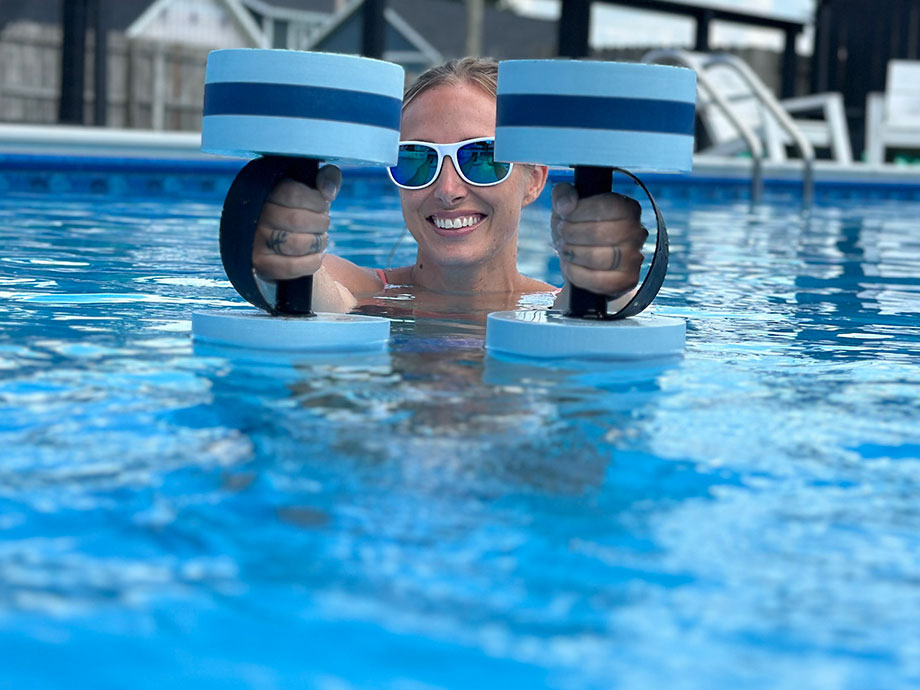
Running strengthens your lower-body muscles—quadriceps, glutes, hamstrings, and calves. There’s some upper-body movement, but not enough that it qualifies as full-body exercise.
RELATED: 14 Running Workouts
What Are the Benefits of Swimming?
We’ve already touched on the calories you can burn swimming. But swimming offers benefits beyond using calories. It’s a full-body workout for all ages and sizes. It also may help improve insulin resistance and mental health and reduce your chance of developing certain diseases.
Full-Body Workout with Less Body and Joint Stress
Swimming qualifies as a full-body workout because your arms, torso, and legs are all utilized while moving your body through the water. You also have the opportunity to activate different muscles when using different strokes. The crawl stroke (freestyle) is the most common, but you can change things up by trying the breaststroke or butterfly stroke to activate slightly different muscle groups.
Swimming puts less stress on the joints than high-impact workouts like running, making it more accessible to those with mobility issues. The water helps support body weight, which can help during pregnancy or for people living with obesity.
The American College of Obstetricians and Gynecologists⁵ includes swimming among the recommended exercises during pregnancy. However, please be sure to:
- Listen to your doctor’s recommendations
- Only swim in areas with appropriately sanitized water
- Listen to your body, as you can tire faster
Reduced Insulin Resistance and High Blood Pressure
Physical activity—including swimming—is a key factor in reducing insulin resistance. The results of a 2019 study published in the Journal of Advanced Pharmacy Education & Research⁶ suggest that aquatic exercises can improve insulin sensitivity in men with type 2 diabetes. Similarly, a 2018 study published in Experimental and Therapeutic Medicine⁷ found that swimming could help improve insulin resistance and chronic inflammation in those with metabolic syndrome.
Swimming can also help you meet the Centers for Disease Control and Prevention’s⁸ (CDC) recommended 150 minutes of moderate-intensity exercise per week. Further, the American Heart Association⁹ (AHA) highly encourages meeting that recommendation to regulate blood pressure and keep your arteries flexible.
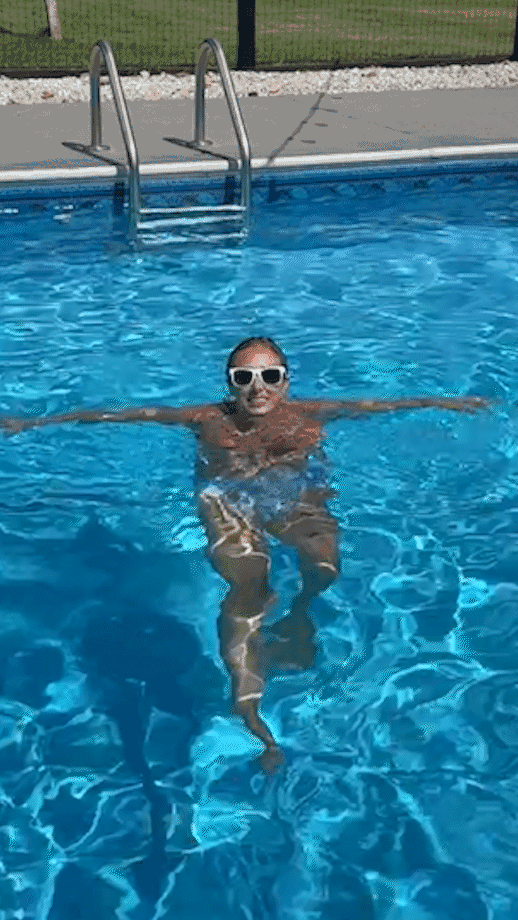
Less Stress and Better Stress Management
Stress may be a natural part of life, but it can have harmful effects if not managed. A 2016 study published in the Universal Journal of Educational Research¹⁰ concluded that swimming could reduce stress in 11 to 13-year-old children. A small 2020 study published in Complementary Therapies in Medicine¹¹ concluded that swimming—whether for leisure or competition—can help positively impact mental health.
What Are the Benefits of Running?
You already know running can burn calories, but like swimming, the benefits go beyond increasing your heart rate and weight loss. Running improves heart health, reduces disease risk, and can be another tool for controlling stress and improving mental health.
Disease Prevention
This form of exercise helps strengthen your heart and lungs. Improved cardiovascular fitness can reduce the chances of developing cardiovascular disease¹², obesity, hypertension¹³, dyslipidemia, type 2 diabetes, respiratory disease, and certain cancers.
Strong Bones
The high impact and resistance of muscle on bone is important for your bone health. In a 2019 study published in the Journal of Exercise Rehabilitation¹⁴, participants who ran regularly were found to have increased bone formation markers and bone density. Consequently, running can act as a preventative measure against bone loss and osteoporosis or osteoarthritis.
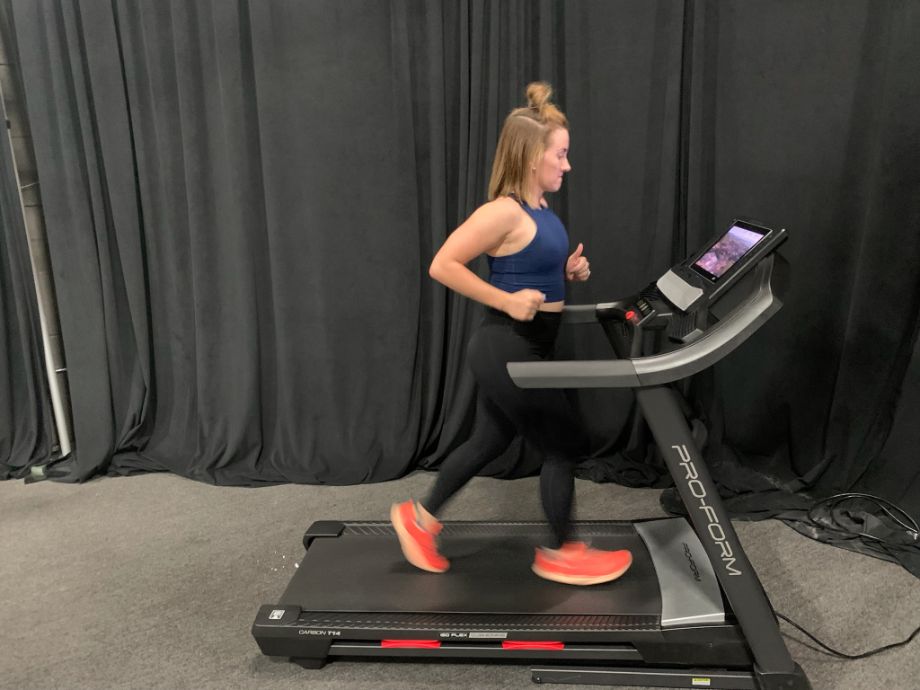
Boost In Mental Health
Running isn’t a cure for mental health issues, but it certainly can be used in mental health management. A 2020 scoping review published in the International Journal of Environmental Research and Public Health¹⁵ explored 16,401 texts and found that overall, aerobic exercise like running has a positive effect on mental health. The exceptions were in cases of exercise addiction. In a 2023 study published in the Journal of Affective Disorders¹⁶, participants who ran showed similar improvements in mental health to those who took antidepressants.
Social Connections
Running groups and organizations are popping up all over the nation. Park runs, for example, are organized in most major cities, where participants of all levels can meet and run through a public park together. A 2022 study published in Frontiers in Sports and Active Living¹⁷ found that social networks can both help create human connections and can be a motivator to stay healthy.
Swimming Vs Running: Which Should You Do?
The benefits of swimming and running, in some ways, are very similar. Both strengthen the cardiovascular system, improve mental health, and help avoid disease. But there are circumstances under which one might be better for you.
If you’re overweight, pregnant, or have joint and mobility issues, swimming’s low impact offers a safe way to get a full-body workout. But swimming doesn’t have the weight-bearing benefits of running, and you might have trouble finding somewhere to swim nearby. In contrast, running is easily accessible. Typically, all you need is a good pair of running shoes and a safe place to run. It also builds strength and can help maintain bone density. But it can be hard on the body.

A little of both would be ideal. If you must choose, pick the one that works for your location, fitness level, and health conditions.
Swimming Vs Running: Final Thoughts
You can’t go wrong with a regular swimming or running routine. These cardio forms can help strengthen your heart and lungs and improve your physical and mental health. Keep the following in mind while making your choice:
- While the calorie burn is similar between these two exercises, running generally burns more calories per minute.
- Swimming is a full-body workout that uses your arms, back, abdominals, and legs.
- Running offers weight-bearing benefits and helps strengthen your bones.
- Swimming is low impact and non-weight bearing, which is a good option for those with joint or mobility problems.
Swimming Vs Running: FAQs
Is swimming more effective than running?
When it comes to muscle activation, swimming is more effective than running. Swimming activates your entire body, whereas running activates your lower body primarily. However, if you look at overall calorie burn, minute by minute, running burns more calories.
What is the 1-mile swimming equivalent of running?
Generally, four miles of running equals one mile of swimming. The human body was made to run, but it wasn’t necessarily made to swim. Consequently, it takes more work and time to go an equal distance swimming.
Is swimming or running better for mental health?
Swimming and running are equally good for mental health. Whichever cardio you like and can create a regular fitness routine around will offer mental health benefits. Remember that swimming and/or running don’t replace mental health care. However, they can complement treatments that may include medication and regularly seeing a mental health professional.
References
- American Council on Exercise. Tools & calculators. https://www.acefitness.org/resources/everyone/tools-calculators/physical-activity-calorie-counter/
- Drenowatz, C. et al. (2015). The association between different types of exercise and energy expenditure in young non-overweight and overweight adults. Applied Physiology, Nutrition, and Metabolism. 40(3): 211-217. doi:10.1139/apnm-2014-0310
- Nystoriak, M.A. and Bhatnagar, A. (2018). Cardiovascular effects and benefits of exercise. Frontiers in Cardiovascular Medicine. https://doi.org/10.3389/fcvm.2018.00135
- Currie, K. D., et al. (2018). Left ventricular structure and function in elite swimmers and runners. Frontiers in Physiology. 9. https://doi.org/10.3389/fphys.2018.01700
- The American College of Obstetricians and Gynecologists. (2022). Exercise During Pregnancy. https://www.acog.org/womens-health/faqs/exercise-during-pregnancy
- Rezaeimanesh, D. and Farsani P. A. (2019). The effect of an 8-week selected aquatic aerobic training period on plasma Leptin and insulin resistance in men with type 2 diabetes. Journal of Advanced Pharmacy Education & Research. 9(S2): 121-124.
- Tan, J. and Guo, L. (2018). Swimming intervention alleviates insulin resistance and chronic inflammation in metabolic syndrome. Experimental and Therapeutic Medicine. 17(1): 57-62. https://doi.org/10.3892/etm.2018.6900
- Centers for Disease Control and Prevention. (2023). Adult activity: An overview. https://www.cdc.gov/physical-activity-basics/guidelines/adults.html
- The American Heart Association. (2024). Getting active to control high blood pressure. https://www.heart.org/en/health-topics/high-blood-pressure/changes-you-can-make-to-manage-high-blood-pressure/getting-active-to-control-high-blood-pressure
- Koroglu, M. and Yigiter, K. (2016). Effects of swimming training on stress levels of the students aged 11-13. Universal Journal of Educational Research. 4(8): 1881-1884. DOI: 10.13189/ujer.2016.040818
- Jackson, M., Kang, M., Furness, J., & Kemp-Smith, K. (2022). Aquatic exercise and mental health: A scoping review. Complementary Therapies in Medicine. 66: 102820. https://doi.org/10.1016/j.ctim.2022.102820
- Mehta, A. et al. (2020). Running away from cardiovascular disease at the right speed: The impact of aerobic physical activity and cardiorespiratory fitness on cardiovascular disease risk and associated subclinical phenotypes. Progress in Cardiovascular Disease. 63(6): 762-774. https://doi.org/10.1016/j.pcad.2020.11.004
- Lavie, C.J., et al. Effects of running on chronic diseases and cardiovascular and all-cause mortality. Mayo Clinic Proceedings. 90(11): 1541-1552. https://doi.org/10.1016/j.mayocp.2015.08.001
- Lee, J. H. (2019). The effect of long-distance running on bone strength and bone biochemical markers. Journal of Exercise Rehabilitation. 15(1): 26-30. DOI: 10.12965/jer.1836564.282
- Oswald, F., et al. (2020). A Scoping Review of the Relationship between Running and Mental Health. International Journal of Environmental Research and Public Health, 17(21). https://doi.org/10.3390/ijerph17218059
- Verhoeven, J. E., et al. (2023). Antidepressants or running therapy: Comparing effects on mental and physical health in patients with depression and anxiety disorders. Journal of Affective Disorders. 329: 19-29. https://doi.org/10.1016/j.jad.2023.02.064
- Franken, R., Bekhuis, H., and Tolsma, J. (2022). Running together: How sports partners keep you running. Frontiers in Sports and Active Living. 4. https://doi.org/10.3389/fspor.2022.643150
Further reading

A running veteran and certified personal trainer shares top picks for the best running shoes for beginners. Read more

Ski jumps build muscle in your lower body and improve your cardio fitness. A personal trainer explains how to do them with proper form and mistakes to avoid. Read more

Looking to give boxing a try? Here are 5 benefits of boxing that can help level up your health and fitness routine. Read more

In this RSP Nutrition Amino Lean pre-workout review, one of our testers shares her thoughts on the formulation and effects of this sports nutrition supplement. Read more

